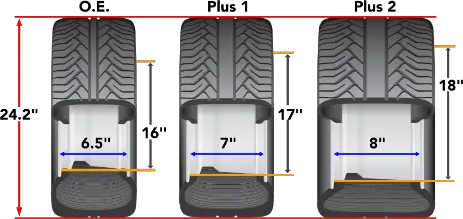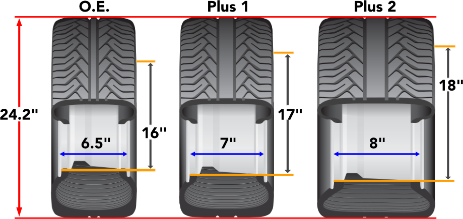As a car owner, you may have wondered whether you can put wider tires on your vehicle. Perhaps you’re interested in enhancing the performance of your car, or maybe you want to improve its appearance. Whatever your reasons may be, it’s important to understand the benefits and drawbacks of installing wider tires on your car, as well as the factors to consider before making such a modification.
Wider tires can provide numerous benefits for your car, such as improved handling, better traction, and increased stability on the road. These tires also have a larger contact patch with the ground, which can make your car more responsive and easier to control. However, before you rush to purchase new tires, you need to consider factors such as wheel size, clearance, and the impact on your car’s suspension system. In this article, we’ll explore these factors in more detail and help you determine whether wider tires are the right choice for your car.
Yes, you can put wider tires on your car but there are a few things you need to consider first. Wider tires can improve the handling and appearance of your car, but they also have the potential to negatively affect fuel economy and increase road noise. It’s important to check if the wider tires will fit within your wheel well, and if they are compatible with your car’s suspension and alignment. Consult a professional mechanic to ensure proper installation and safety.

Can I Put Wider Tires on My Car?
If you’re looking to customize your car or improve its performance, you may be wondering if you can put wider tires on it. The answer is yes, you can put wider tires on your car, but there are a few things you should consider before doing so.
1. Benefits of Wider Tires
Wider tires can offer several benefits to your car, including:
- Improved handling: Wider tires provide more contact with the road, which can improve your car’s handling and grip.
- Better traction: Wider tires can provide better traction on wet or slippery roads.
- Enhanced appearance: Wider tires can give your car a more aggressive and sporty look.
However, it’s important to note that wider tires can also have some drawbacks.
2. Drawbacks of Wider Tires
Some of the potential drawbacks of wider tires include:
- Increased rolling resistance: Wider tires can cause more rolling resistance, which can decrease your car’s fuel efficiency.
- Possible rubbing: If the tires are too wide for your car’s wheel wells, they can rub against the fenders or suspension components, causing damage and affecting your car’s handling.
- Increased noise: Wider tires can produce more road noise and vibrations, which can make for a less comfortable ride.
3. How to Determine If Wider Tires Will Fit Your Car
Before putting wider tires on your car, you’ll need to determine if they’ll fit properly. There are a few things you should consider:
- Wheel size: The width of your tires should be compatible with your car’s wheel size. You can usually find this information in your car’s owner’s manual or on the tire placard located on the driver’s side doorjamb.
- Clearance: You’ll need to make sure there’s enough clearance between the tires and the wheel wells, suspension components, and other parts of your car. You can measure this by taking a ruler or tape measure and measuring the distance between the tire and the closest part of the car.
- Speed rating: Make sure the wider tires have a speed rating that’s compatible with your car. You can find this information on the tire’s sidewall.
4. Pros and Cons of Plus-Sizing Your Tires
Plus-sizing your tires is a popular way to increase the width of your tires. This involves increasing the diameter of the wheel and the width of the tire to maintain the overall diameter of the tire. There are some pros and cons to consider:
- Pros: Plus-sizing can improve the appearance of your car, increase handling and grip, and provide a more comfortable ride.
- Cons: Plus-sizing can be expensive, and you may need to modify your car’s suspension to accommodate the larger wheels and tires. It can also decrease your car’s fuel efficiency.
5. Wider Tires vs. Narrower Tires
When it comes to choosing between wider and narrower tires, there are a few things to consider:
- Handling: Wider tires can provide better handling and grip, while narrower tires can provide better fuel efficiency and a smoother ride.
- Appearance: Wider tires can give your car a sportier look, while narrower tires can give it a more classic or vintage look.
- Cost: Wider tires can be more expensive than narrower tires.
6. Conclusion
In conclusion, you can put wider tires on your car, but it’s important to consider the potential benefits and drawbacks. Before making any changes to your car’s tires, make sure you do your research and consult a professional if you’re unsure. With the right tires, you can improve your car’s performance and appearance, but it’s important to choose wisely.
Key Takeaways: Can I Put Wider Tires on My Car?
- Wider tires can improve handling and traction, but may also negatively affect fuel efficiency and ride comfort.
- Consult your car’s manual or a tire professional to determine the maximum tire width your car can accommodate.
- It’s important to match the tire width with the appropriate wheel size to ensure proper fit and performance.
- Wider tires may require a suspension upgrade to maintain proper clearance and handling.
- Consider the climate and driving conditions in your area when choosing tire width, as wider tires may perform better in certain situations.
- Remember to always replace tires in pairs or sets to maintain consistent performance and handling.
When considering putting wider tires on your car, it’s important to weigh the potential benefits against potential drawbacks. While wider tires can improve handling and traction, they may also negatively affect fuel efficiency and ride comfort. To ensure proper fit and performance, it’s important to consult your car’s manual or a tire professional to determine the maximum tire width your car can accommodate, and to match the tire width with the appropriate wheel size. Additionally, wider tires may require a suspension upgrade to maintain proper clearance and handling. Consider the climate and driving conditions in your area when choosing tire width, as wider tires may perform better in certain situations. Finally, remember to always replace tires in pairs or sets to maintain consistent performance and handling.
Can I change my tire size
There’s no doubt that larger tires can enhance the performance and aesthetics of your car. However, before you jump into replacing your car’s tires, it’s essential to understand the compatibility and legality aspects of installing wider tires. Many factors come into play, such as the size of your wheels, vehicle make and model, and state regulations. Therefore, it’s always wise to consult with a tire professional or mechanic to ensure that you make the best decision for your car.
In summary, installing wider tires on your car can provide numerous benefits, but it’s crucial to weigh the pros and cons before making any changes. It’s essential to consider your car’s specifications, driving conditions, and legal requirements before deciding to install wider tires. By doing so, you can ensure that your car remains safe, performs well, and looks fantastic.

